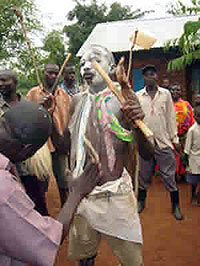Being the oldest surgical procedure in the world, circumcision has stood the test of time and continues to be of grave importance in some tribes. Children have been initiated into their respective tribes, through circumcision, to signify a child?s acceptance into the tribe and secure his or her place in the adult community.


Being the oldest surgical procedure in the world, circumcision has stood the test of time and continues to be of grave importance in some tribes.
Children have been initiated into their respective tribes, through circumcision, to signify a child?s acceptance into the tribe and secure his or her place in the adult community.
In East Africa, most tribes that circumcise boys also circumcise girls. Female Genital Mutilation (FGM), also controversially known as female circumcision, has for the past several decades been denounced by the World Health Organisation.
The 6th of February was declared as International Day against FGM. Although the inhumane and savage act has decreased in some of these tribes, it is still in practice.
The Sebei also known as Sabiny, are a tribal group living in the North and North Western slopes of Mt. Elgon and on the plains below Eastern Uganda who are most known for this act.
The Sebei initiate both boys and girls through circumcision. The male cutting is formally organized and conducted every two years whereas the female cutting is performed annually.
Be strong or be the shame of your community is the mantra for these girls, crying out or even uttering a sound during the ritual would deeply embarrass their families and themselves.
Moving on to the western and southern halves of Mt. Elgon, are a tribal group known as the Bagishu. These people however only circumcise their males and the ritual is one that has fascinated so many people?its a ceremony so interesting that many do not mind watching.
The famous ?embalu? dance and the boys covered in a white substance are eye catching but the highlight, is the fierce and courageous faces of the boys as one by one they await the razor without a twitch or sound.
Every male upon reaching puberty has to undergo the ritual. Those who abscond are hunted down and forcefully and scornfully circumcised.
Before circumcision a ritual is administered with herbs called Ityanyi which enables the boy to stay focused on the ritual such that if the cutter delays, the boy is capable of cutting himself. Once the boy is cut, he becomes a true Mugishu and a mature person. A boy or man that is not circumcised is called a Musani.
For three days prior to circumcision, boys are not allowed to eat with their hands and are fed by other people because it is said that he is not yet fully initiated into manhood.
Unlike their neighbours the Sebei, the Bagishu have no record of Female Genital Mutilation.
As for the Kikuyu, it is the biggest tribe in Kenya and of all their life stages, circumcision was and remains by far the most important, signifying not only a child?s passage to adulthood but a whole wealth of their meaning and responsibility.
Male circumcision was traditionally a public affair which only added anxiety and determination of the boys to pass the ordeal without showing the slightest trace of fear.
To the Mau Mau, circumcision was an aspect of traditional life although some of them took this a step further, arguing that anyone who had not been circumcised or refused their children to be circumcised was an enemy to the Mau Mau.
In some tribes, it is still being done the old way, the brave way. But nowadays it is being performed in hospitals more humanely because the results are the same.


